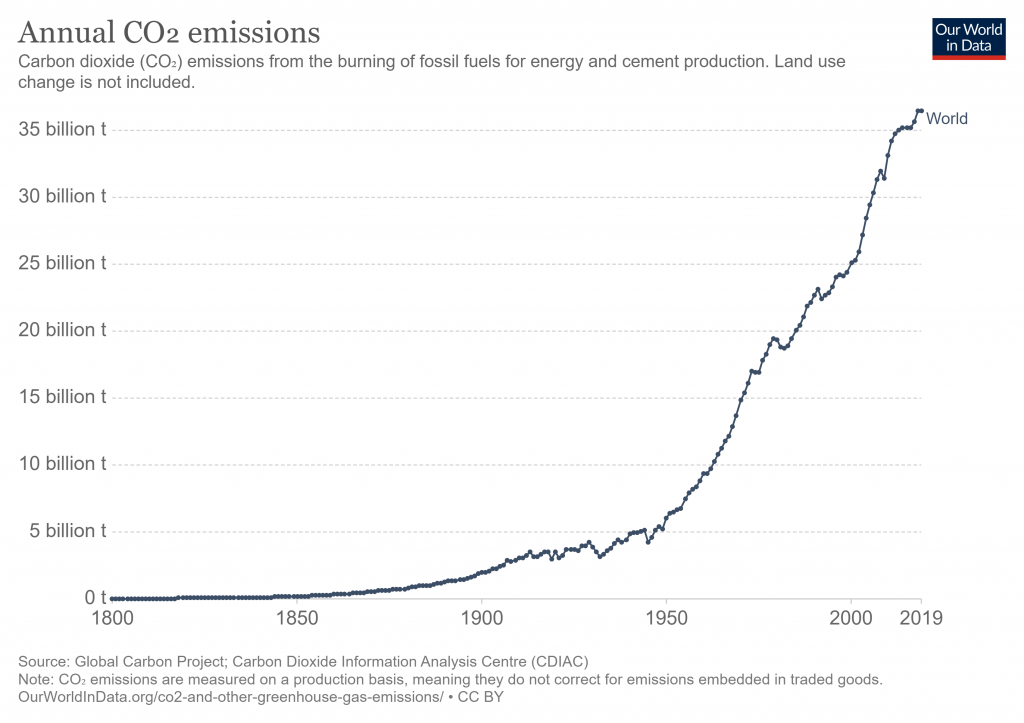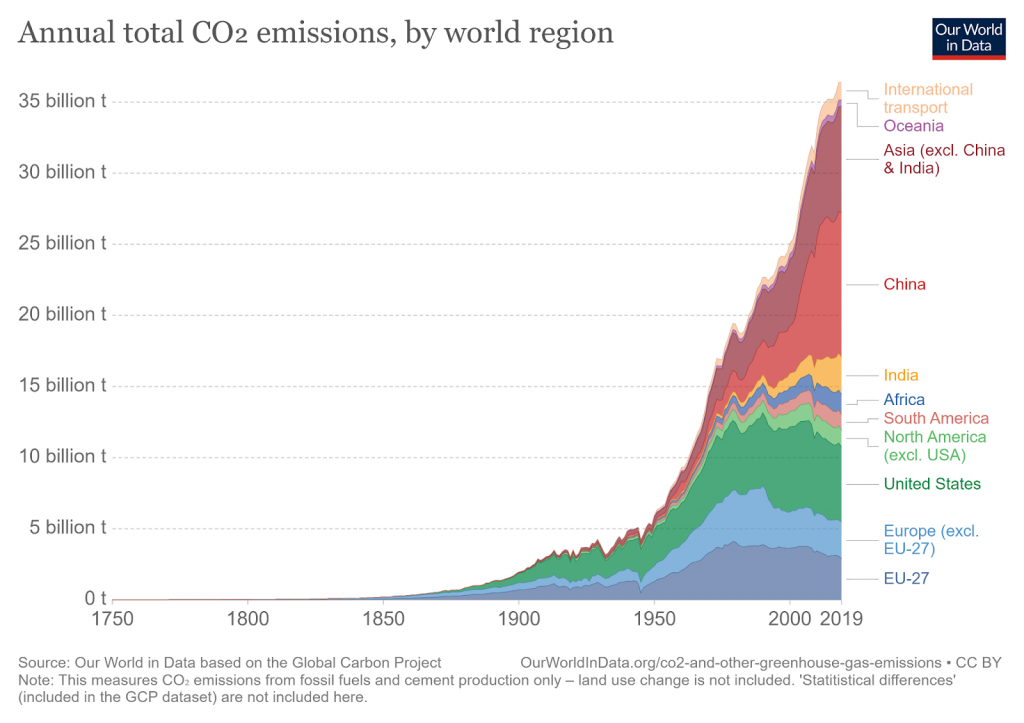Can You Really Offset Your Carbon Footprint? Here Are the Facts
Impactful Ninja is reader-supported. When you buy through links on our site, we may earn an affiliate commission.
Learn more
Learn more
.
Hey fellow impactful ninja ? You may have noticed that Impactful Ninja is all about providing helpful information to make a positive impact on the world and society. And that we love to link back to where we found all the information for each of our posts. Most of these links are informational-based for you to check out their primary sources with one click. But some of these links are so-called "affiliate links" to products that we recommend. First and foremost, because we believe that they add value to you. For example, when we wrote a post about the environmental impact of long showers, we came across an EPA recommendation to use WaterSense showerheads. So we linked to where you can find them. Or, for many of our posts, we also link to our favorite books on that topic so that you can get a much more holistic overview than one single blog post could provide. And when there is an affiliate program for these products, we sign up for it. For example, as Amazon Associates, we earn from qualifying purchases. First, and most importantly, we still only recommend products that we believe add value for you. When you buy something through one of our affiliate links, we may earn a small commission - but at no additional costs to you. And when you buy something through a link that is not an affiliate link, we won’t receive any commission but we’ll still be happy to have helped you. When we find products that we believe add value to you and the seller has an affiliate program, we sign up for it. When you buy something through one of our affiliate links, we may earn a small commission (at no extra costs to you). And at this point in time, all money is reinvested in sharing the most helpful content with you. This includes all operating costs for running this site and the content creation itself. You may have noticed by the way Impactful Ninja is operated that money is not the driving factor behind it. It is a passion project of mine and I love to share helpful information with you to make a positive impact on the world and society. However, it's a project in that I invest a lot of time and also quite some money. Eventually, my dream is to one day turn this passion project into my full-time job and provide even more helpful information. But that's still a long time to go. Stay impactful,Affiliate Disclosure
Why do we add these product links?
What do these affiliate links mean for you?
What do these affiliate links mean for us?
What does this mean for me personally?
![]()
To ensure a sustainable planet for future generations we must take action now to reduce greenhouse gas emissions and our carbon footprint. Carbon offsets are one of the ways in which we can do this, but it may be only a mitigation strategy rather than a cure-all. So, we had to ask: can you really offset your carbon footprint?
Carbon offsets do not directly reduce your own carbon footprint. Carbon offsets are monetary investments in environmental projects that reduce CO2 emissions elsewhere and then attribute it to you. While they reduce global emissions, your personal carbon emissions remain the same.
Keep reading to find out what your carbon footprint is, what carbon offsets are, how carbon offsets impact your carbon footprint, and why carbon offsets may not be the most effective way to mitigate climate change.
What Is Your Carbon Footprint and What Is Carbon Offsetting
A carbon footprint is the amount of carbon dioxide (CO2) emissions associated with an individual or an entity. By focusing on the greenhouse gas (GHG) emissions associated with consumption, it is one of the ways that we measure the effects of human-induced global climate change.
“Carbon footprint: the amount of greenhouse gases and specifically carbon dioxide emitted by something (such as a person’s activities or a product’s manufacture and transport) during a given period”
Merriam Webster
Basically, it is the amount of carbon emitted by an activity or an organization. This includes GHG emissions from fuel that we burn directly (e.g. heating a home, driving a car) and GHG emissions from manufacturing the products that we use (e.g. power plants, factories, and landfills). It also includes other emissions such as methane, nitrous oxide, and chlorofluorocarbons.
When you hear the words “carbon offset”, think about the term “compensation”. Essentially, carbon offsets are reductions in GHG emissions that are used to compensate for emissions occurring elsewhere.
“Carbon offset: a way for a company or person to reduce the level of carbon dioxide for which they are responsible by paying money to a company that works to reduce the total amount produced in the world, for example by planting trees”
Oxford Dictionary
Carbon offsets are a way to invest in environmental projects that reduce carbon emissions in order to compensate for your own carbon footprint. We already have governmental-level policies in place to reduce GHGs, but carbon offsets can help us reduce emissions from activities where sustainable alternatives are not yet widely available.
Carbon offsets play an important role in mitigating the effects of global climate change by reducing GHG emissions beyond what we each can achieve through individual actions. They are measured in tons of CO2 equivalents and are bought and sold through international brokers, online retailers, and trading platforms.
Carbon offsets can range anywhere from a couple of hundred tons of CO2 per program per year to thousands of tons of CO2 per program per year. Travel, renewable energy, energy efficiency, and carbon sequestration are just some of the areas that provide carbon offset projects. Because GHGs are found everywhere in our atmosphere, cutting GHGs at any location on earth provides emission reduction benefits.
Here’s How Carbon Offsetting Impacts Your Carbon Footprint
Carbon offsets reduce GHG emissions from human consumption of resources. Reducing your consumption of these, in turn, reduces your carbon footprint. And this has huge impacts on environmental, economic, and public health.
| Overview | Summary |
| What is your personal carbon footprint | The sum of CO2 emissions from all of your activities, including transportation, home, and food usage. |
| How offsetting your personal carbon footprint works | You purchase offsets on behalf of a large corporation or on the voluntary market. Your money is used to fund projects that reduce GHG emissions. |
| How carbon offsetting impacts your carbon footprint | Your personal carbon footprint remains the same even after you offset it. |
| Why reducing your carbon footprint is more effective than offsetting it | Offsets are indirect methods of CO2 reduction whereas reducing your carbon footprint eliminates emissions before they even occur. |
What Is Your Personal Carbon Footprint
Your personal carbon footprint is the collective CO2 emissions generated from all of your activities. This includes, but is not limited to, the method and distance you travel everyday, how much water you use, how you power your home, the type and quantity of food that you consume, and how much money you spend on shopping.
The average carbon footprint is approximately 4 tons. In order to prevent a 2℃ (or, even better, a 1.5°C) rise in global temperature, this number needs to decrease to well under 2 tons by the year 2050. This means we all still have a lot of work to do!

Globally, we pump over 36 billion tons of CO2 into the atmosphere every year, which causes climate change. Climate change results in global warming, when CO2 and other air pollutants absorb sunlight and solar radiation in the atmosphere, thereby trapping the heat and acting as an insulator for the planet.
“Climate Change: changes in the world’s weather, in particular the fact that it is believed to be getting warmer as a result of human activity increasing the level of carbon dioxide in the atmosphere”
Cambridge Dictionary
Since the Industrial Revolution, Earth’s temperature has risen a little more than 1 degree Celsius (C), or 2 degrees Fahrenheit (F). Between 1880-1980 the global temperature rose by 0.07C every 10 years. This rate has more than doubled since 1981, with a current global annual temperature rise of 0.18C, or 0.32F, for every 10 years.
Experts claim that to avoid a future plagued by rising sea levels, acidified oceans, loss of biodiversity, more frequent and severe weather events, and other environmental disasters, we must limit global warming to 1.5C by 2040.
How Does Offsetting Your Personal Carbon Footprint Work
It is important to note that your carbon footprint remains the same even after you offset it. Offsets work by reducing emissions in other places, so you are effectively reducing the carbon footprint of something else but then attribute it to yourself because you paid to offset it.
To offset our carbon footprint, you first must determine what your individual carbon footprint is. The United States Environmental Protection Agency (US EPA) provides a calculator so you can determine your carbon footprint in three areas: home energy, transportation, and waste. Everyone’s location, habits, and personal choices are different, so it is important to first know where you fall on the emissions scale before you begin to reduce it.
How Carbon Offsetting Impacts Your Carbon Footprint
Carbon offsetting aims to reduce the consumption of fossil fuels which, in turn, reduces your carbon footprint. But one of the main limitations of carbon offsetting is that purchasing a carbon offset does not directly reduce your carbon footprint. It only makes others reduce their carbon footprint to compensate for your carbon footprint.
Because offsetting is an indirect way and not a direct way of reducing emissions, it alone will not be enough to significantly reduce global carbon emissions. Coupled with direct measures of emission reductions, such as reducing individual energy use and consumption, offsetting can be more effective.
Why Reducing Your Carbon Footprint Is More Effective Than Offsetting It
The main argument against carbon offsets is that they don’t really work. Instead of substituting offsetting carbon emissions, we should instead cut the emissions directly at the source. Basically, if we stop emissions from getting into the atmosphere in the first place, we won’t have to worry about offsetting. But have we done this? Have we cut emissions directly at the source? The data says no.
The COVID-19 pandemic triggered the largest decrease in energy-related carbon emissions since World War II, a decrease of 2 billion tons. However, emissions rebounded quickly at the end of 2020, with levels in December ending 60 million tons higher than those in December 2019. This indicates that the earth is still warming at an accelerated rate, and not enough is being done to implement clean energy practices.

When you buy a carbon offset, you are paying someone else to cut their emissions so you don’t have to cut your own emissions. This is why offsetting alone will not be enough to reduce global carbon emissions.
Carbon offsets are a good place to start if you want to get into the carbon-emission reduction game, but in order to be effective in the long term, we must not rely on them solely. Cutting emissions from the source and then offsetting the remainder is the best way to reduce our carbon footprint and provide the highest environmental benefits. If we fail to cut emissions first, we will fill up our carbon sinks and render them unusable. Preventing carbon emissions rather than reacting once they are already emitted is the best way to reduce overall emissions.
Carbon offsets reduce GHG emissions from coal, oil, and natural gas. Reducing your consumption of these, in turn, reduces your carbon footprint, which has huge impacts on environmental, economic, and public health. A reduced carbon footprint due to lower GHG emissions can mitigate the effects of climate change, improve public health, boost the economy, and maintain plant and animal diversity.
- Climate change: Reducing your carbon footprint plays a role in mitigating the side effects of global climate change. The more we reduce the amount of GHG emissions, the more we slow the rate of temperature rise, sea-level rise, ice melting, and ocean acidification.
- Public health: Reducing GHG emissions lessens the likelihood and severity of extreme weather events, improves air and water quality, maintains biodiversity, and supports a healthy food supply.
- Economics: Reducing GHG boosts the economy, especially when it becomes economically rewarding to innovate solutions that help protect our planet, fight climate change, and are based on clean energy.
- Plant and animal diversity: Protecting biodiversity protects human health because many plants and animals are used in modern medicines
Carbon offsets have the potential to instigate meaningful environmental change, but to make the greatest impact we must understand both their benefits AND drawbacks.
What Are the Benefits of “Offsetting Your Carbon Footprint”
To be beneficial, carbon offsets must be additional. That means that these projects must reduce GHG emissions more than would have occurred if there were no projects to begin with. They must also be permanent, in the sense that a tree planted to offset carbon should not be removed.
If – and only if – this is the case, then carbon offsets can help reduce your overall GHG emissions to balance off your personal carbon footprint to fight climate change – at least in the short term. But their benefits even go beyond that.
- Improves air quality: Degradation of air quality as a result of carbon emissions is a serious issue. In 2009, the US government declared CO2, CH4, N2O, hydrofluorocarbons (HFCs), perfluorocarbons (PFCs), and sulfur hexafluoride (SF6) threats to the public health and welfare of current and future generations. Reducing C02 emissions would lead to improved public health in terms of asthma, respiratory allergies, airway diseases, and lung cancer.
- Protects ecosystems: Healthy ecosystems have been linked with cleaner air, water, and food. Protecting forest habitats increases carbon sequestration and defends against erosion. Protecting agricultural land ensures a robust, secure, and prosperous food system. Protecting aquatic ecosystems ensures a readily available supply of freshwater.
- Supports green jobs: The renewable energy sector employed 11.5 million people worldwide in 2019, with solar energy making up the bulk of those jobs. Renewable energy jobs continue to increase as we start to realize just how beneficial renewable energy is for our environment.
If used correctly, carbon offsets can provide environmental, economic, and social benefits that go beyond reducing GHG emissions.
What Are the Drawbacks of “Offsetting Your Carbon Footprint”
The global carbon offset market was estimated at nearly $10 billion in 2010 and has since grown to represent anywhere between $40 billion and $120 billion. But despite all of its success, carbon offsetting is not without its limitations.
The following 9 major limitations should be taken into account when implementing carbon offset programs:
- When you purchase a carbon offset, you are paying someone else to cut their emissions so you don’t have to cut your own emissions.
- Global warming is still occurring at an accelerated rate because offsetting CO2 emissions does not cut CO2 emissions at the source, it only mitigates emissions.
- If carbon offset projects are not additional and permanent, they can make climate change worse because they are not offsetting any carbon.
- The richest of the world emit the majority of the world’s carbon. Offsets are just licenses to pollute with the benefit of aiding those in developing countries.
- The varying levels of effectiveness of carbon offset programs make it difficult to choose one that actually reduces emissions. The most effective offset programs are renewable energy programs, followed by energy efficiency improvements, carbon sequestration, and aviation offset programs.
- If a carbon offset program is not carried out until the end, then we cannot reap the program’s benefits. For example, planting trees is a common offset program that is only effective if those planted trees are protected during their life span for the carbon benefits to be realized.
- We emit far more CO2 than we can offset because of carbon sink (e.g., atmosphere, forests, soil, ocean) limitations.
- Of the credits for 1 billion tons of CO2 listed on registries, only about 300-400 million tons of CO2 offsets actually get realized.
- Investing in non-verified credits, not prioritizing in-house emissions reductions, and double-counting carbon credits are methods of greenwashing. Also, companies may advertise a specific program, but it may be just for public attention instead of to actually reduce emissions.
These limitations make the current voluntary carbon market (VCM) fragmented and complex, which leads to confusion, inconsistencies, and general distrust of the system.
How You Can Make Carbon Offsetting More Effective
While it isn’t possible to overcome all of the carbon offsetting limitations, there are ways to overcome some of the limitations. And it all starts with our individual actions.
There are 9 main carbon offsetting limitations. Below we have highlighted the 5 main limitations and included the most effective ways to overcome them. You can check out the full article here: “What Are the Biggest Carbon Offsetting Limitations? (All 9 Explained)”
| Carbon Offsetting Limitation | Ways to Overcome This Limitation |
| #1: You don’t reduce your own carbon footprint | Ways to directly decrease your carbon footprint without using offsets include: wash with cold water, replace incandescent bulbs with fluorescent bulbs, fly less, walk or bike when possible, switch to renewable energy sources, recycle, take shorter showers, or eat less meat and dairy. |
| #2: Carbon offsets do not work at the core issue of reducing CO2 emissions | Choose carbon offset projects that meet key criteria and project standards. |
| #3: Carbon offsetting only reduces CO2 if the projects are additional and permanent | Choose carbon offset projects that meet key criteria and project standards. |
| #5: Different projects have different effectiveness rates | Of the most prevalent offset programs, renewable energy programs are the most effective, followed by energy efficiency improvements, carbon sequestration, and aviation offset programs. |
| #7: There are not enough offsets for all CO2 emissions | Reduce your own carbon footprint before turning to offsets. This mitigates stress to our environmental sinks and keeps the environment healthy while reducing emissions. |
Many of the limitations of carbon offsetting can be overcome by focusing on reducing your own emissions first. Offsets are best used as a supplement to individual emissions reductions because they are indirect methods of reductions.
What Key Criteria Should You Look For in Carbon Offsetting Programs
Carbon offsets are designed for situations where emissions are impossible to reduce because you can use the funds to reduce emissions in other areas. Carbon offset programs are designed to do just that.
Here are key criteria to look for in a carbon offset program:
- A clearly defined protocol that determines which types of projects are eligible and how emission reductions will be measured
- Independent third-party verification of compliance with the protocol
- Registration of offsets in an offset registry, which tracks each credit with a unique serial number to ensure it is only used once
- Transparency in project implementation and reporting
Carbon offset projects are part of carbon offset programs. When researching carbon offset projects, a good place to start is with the carbon offset project standards. These assure transparency and quality in the creation, quantification, and verification of offset projects. This way you can ensure that the project you eventually choose is actually reducing CO2 emissions.
- Verified Carbon Standard (VCS): Considered the world’s leading voluntary GHG program, with 1700+ projects having removed 630+ million tons of CO2 from the atmosphere. Examples of projects include hydropower in Turkey, forest conservation in Peru, and landfill gas capture in China.
- Gold standard: A certification that seeks to maximize every dollar of climate and development funding. It has issued 134 million carbon credits from 1700+ projects based in more than 80 different countries. Examples of projects include solar power in India, efficient cooking and heating in China, and wind power in Indonesia.
- Climate Action Reserve (CAR): The premier carbon offset registry for the North American carbon market having issued over 150 million offset credits since its inception in 2001. Examples of projects include landfill gas capture in South Carolina and forest management in California.
- American Carbon Registry (ACR): The first private voluntary GHG registry in the world. Examples of projects include ozone-depleting substances in Arkansas and methane capture from mines in Kentucky.
The most widely known and utilized carbon offset projects are travel, renewable energy, energy efficiency, and carbon sequestration.
- Aviation: Air travel accounts for approximately 1.9% of global GHG emissions and 2.5% of CO2 emissions. Roughly 40 airlines globally offer voluntary offsetting programs, where passengers pay more for a flight to fund projects that will reduce CO2 emissions.
- Renewable energy: The generation of energy from natural resources rather than from fossil fuels creates a reduction in GHG emissions. Solar and wind farms are common carbon offset projects. Renewable energy accounted for 11% of total global energy consumption in 2019, and this number is only expected to increase in the future.
- Energy efficiency improvements: These offset projects are designed to create products or systems that use less energy than conventional systems to perform the same task. Common projects include the widespread installation of LED light bulbs and efficient cooking stoves.
- Carbon sequestration: Defined as the long-term storage of carbon in plants, soils, geologic formations, and the ocean. The Kyoto Protocol allows countries to receive credits for carbon-sequestration activities including afforestation, reforestation, improved forestry, improved agricultural practices, and revegetation.
Choosing a carbon offset project from any of the above project standard registries helps ensure that your project is verified and that it actually reduces CO2 emissions.
What Are the Main Ways to Reduce Your Carbon Footprint
You don’t have to make drastic changes in your lifestyle to reduce your carbon footprint. Actions that may seem small can have a big impact because those small changes add up! You can reduce your carbon footprint in three main areas of your life: household, travel, and lifestyle.
Reduce your household footprint:
- Wash with cold water: Washing clothes in cold water could reduce carbon emissions by up to 11 million tons. Approximately 90% of the energy is used to heat the water, so switching to cold saves also saves energy.
- Replace incandescent bulbs with fluorescent bulbs: Fluorescent bulbs use 75% less energy than incandescent ones, saving energy and thus reducing electricity demand and GHG emissions.
Reduce your travel footprint:
- Fly less: Aviation accounts for around 1.9% of global GHG emissions and 2.5% of CO2. Air crafts run on jet gasoline, which is converted to CO2 when burned.
- Walk or bike when possible: The most efficient ways of traveling are walking, bicycling, or taking the train. Using a bike instead of a car can reduce carbon emissions by 75%. These forms of transportation also provide lower levels of air pollution.
Reduce your lifestyle footprint:
- Switch to renewable energy sources: The six most common types of renewable energy are solar, wind, hydro, tidal, geothermal, and biomass energy. They are a substitute for fossil fuels (e.g., coal and oil) that can reduce the effects of global warming by limiting global GHGs and other pollutants.
- Recycle: Recycling uses less energy and deposits less waste in landfills. Less manufacturing and transportation energy costs means less GHG emissions generated. Less waste in landfills means less CH4 is generated.
- Switch from single-use to sustainable products: Reusing products avoids resource extraction, reduces energy use, reduces waste generation, and can prevent littering.
- Eat less meat and dairy: Meat and dairy account for 14.5% of global greenhouse gas emissions, with beef and lamb being the most carbon-intensive. Globally, we consume much more meat than is considered sustainable, and switching to a vegan or vegetarian diet could reduce emissions.
- Take shorter showers: Approximately 1.2 trillion gallons of water are used each year in the United States just for showering purposes, and showering takes up about 17% of residential water usage. The amount of water consumed and the energy cost of that consumption are directly related. The less water we use the less energy we use. And the less energy we use, the less of a negative impact we have on the environment.
Final Thoughts
Carbon offsets allow us to reduce GHG emissions in ways we wouldn’t be able to accomplish individually. Offset programs involving aviation, renewable energy, energy efficiency, and carbon sequestration can reduce GHG emissions, which improves air quality, protects ecosystems, and supports green jobs. When implemented properly, these benefits can outweigh the drawbacks. But it is also important to remember that using carbon offsets doesn’t change our personal footprint. It only reduces emissions elsewhere.
Carbon offsets are a good place to start if you want to get into the carbon-emission reduction game, but in order to be effective in the long term, we must not rely on them solely. Cutting emissions from the source and then offsetting the remainder is the best way to reduce our carbon footprint and provide the highest environmental benefits. If we fail to cut emissions first, we will fill up our carbon sinks and render them unusable. Preventing carbon emissions rather than reacting once they are already emitted is the best way to reduce overall emissions.
Stay impactful,

Sources
- Impactful Ninja: Why is a Carbon Footprint Bad for the Environment?
- Brittanica: Carbon footprint
- United States Environmental Protection Agency: Climate
- Change Terms – Carbon Footprint
- Our World in Data: CO2 Emissions
- National Resources Defense Council: Global Warming 101
- United Nations Framework Convention on Climate Change: The Paris Agreement
- Britannica: Carbon Offset
- David Suzuki Foundation: Are carbon offsets the answer to climate-altering flights?
- Earth.Org: How Airlines are Adopting Carbon Offsetting
- US Energy Information Administration: Renewable Energy Explained
- Carbon Offset Guide: Energy Efficiency
- Britannica: Carbon Sequestration
- Natural Resources Defense Council: Carbon Offsets 101
- Terrapass: Project Standards
- Verra: Verified Carbon Standard
- Verra: Tepekisla Dam & Hydropower Plant Project
- Verra: The Jaguar Amazon Redd+ Project
- Verra: Sanya Landfill Gas Power Generation Project
- Gold Standard: Gold Standard Impact
- Climate Action Reserve: About Us
- Climate Action Reserve: Registry
- Climate Action Reserve: Bluesource – Berkeley County Landfill Gas Project
- Climate Action Reserve: Buckeye Forest Project
- American Carbon Registry: Our Mission
- American Carbon Registry: Registry
- American Carbon Registry: EOS Climate ODS destruction
- American Carbon Registry: Baker Mine AMM
- Impactful Ninja: 4 Main Reasons Why Reducing Your Carbon Footprint Is Important
- Impactful Ninja: What Is the Carbon Footprint of Coal Energy? A Life-Cycle Assessment
- Impactful Ninja: What Is the Carbon Footprint of Oil Energy? A Life-Cycle Assessment
- Impactful Ninja: What Is the Carbon Footprint of Natural Gas Energy? A Life-Cycle Assessment
- The National Wildlife Foundation: Climate Change
- National Institute of Environmental Health Sciences: Health Impacts of Climate
- Carbon Tax Center: What is a Carbon Tax?
- Carbon Brief: Climate change will hit ‘endemic’ plants and animals the hardest, study warns
- One Green Planet: How Saving Wildlife Benefits Humans – In Ways We Really Need
- World Health Organization: Biodiversity and Health
- National Institute of Environmental Health Sciences: Asthma, Respiratory Allergies and Airway Diseases
- National Institute of Environmental Health Sciences: Cancer
- International Renewable Energy Agency: Renewable Energy Jobs Continue Growth to 11.5 Million Worldwide
- Vox: Can you really negate your carbon emissions? Carbon offsets, explained.
- Carbon Offset Guide: Additionality
- Carbon Offset Guide: Permanence
- The Nature Conservancy: Why We Can’t Afford to Dismiss Carbon Offsetting
- The Guardian: World’s richest 1% cause double CO2 emissions of poorest 50%, says Oxfam
- World Resources Institute: Setting the Record Straight About Renewable Energy
- United States Agency for International Development: Scaling up energy efficiency in developing countries
- GreenPeace: The biggest problem with carbon offsetting is that it doesn’t really work
- ClientEarth: What is a carbon sink?
- Yale Environment 360: Is the ‘Legacy’ Carbon Credit Market a Climate Plus or Just Hype?
- Edie: Carbon offsetting – How are businesses avoiding greenwashing on the road to net-zero?
- McKinsey Sustainability: A blueprint for scaling voluntary carbon markets to meet the climate challenge
- Cold Water Saves: Washing Laundry In Cold Water Protects A Lot More Than Just Our Clothing.
- Energy Star: Compact Fluorescent Light Bulbs (CFLs) and Mercury
- Our World in Data: Where in the world do people have the highest CO2 emissions from flying?
- Our World in Data: Which form of transport has the smallest carbon footprint?
- Stop Waste: Recycling and Climate Protection
- Impactful Ninja: Is Taking Long Showers Bad for the Environment?
- International Energy Agency: After steep drop in early 2020, global carbon dioxide emissions have rebounded strongly
- The Nature Conservancy: Calculate your carbon footprint
- Impactful Ninja: What Are the Biggest Carbon Offsetting Limitations? (All 9 Explained)




